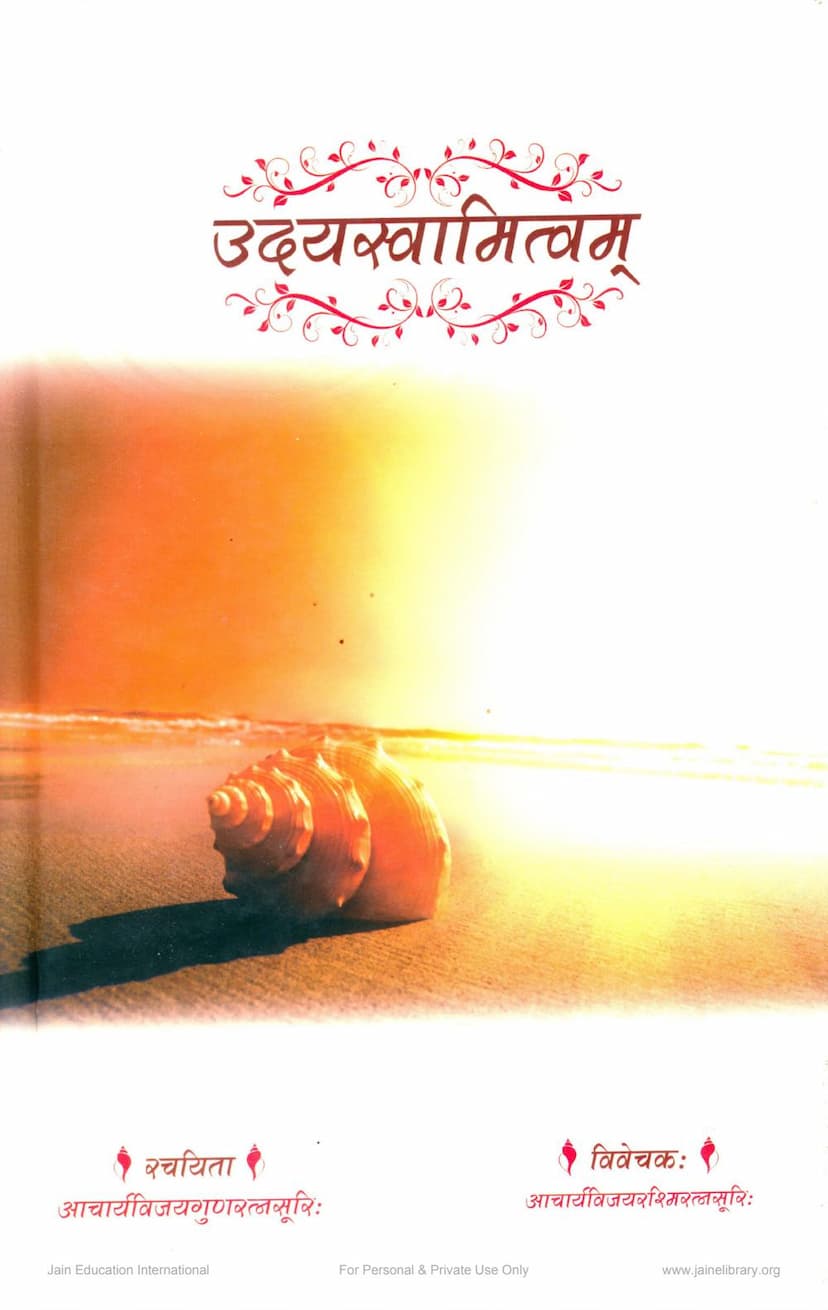Udayswamitvam
Added to library: September 2, 2025

Summary
"Udaysvamitva" (Sense of Ascendancy of Karmic Eruption) is a significant Jain text authored by Acharya Vijaygunratnasuri and commented upon by Acharya Vijayrashmiratnasuri. Published by Jin-gun Aradhak Trust in 2013, this work delves into the intricate details of karma theory, a cornerstone of Jain philosophy.
The central theme of "Udaysvamitva" is to explain, with meticulous precision, how many karmic dispositions (karmaprakriti) are in a state of "udaya" (eruption or manifestation) for beings in different states of existence and spiritual progress. It systematically analyzes this across 62 types of "margana" (modes of existence or spiritual states).
The text is structured around 76 verses (gatha) composed by Acharya Vijaygunratnasuri, which form the core of the original work. The commentary and elaboration are provided by Acharya Vijayrashmiratnasuri, making the complex subject matter accessible.
Key Aspects and Content:
- Detailed Analysis of Karmic Udaya: The book meticulously details which karmic dispositions are present and which are absent at various stages of a soul's journey. This includes examining the state of karma across different life-forms (gati) like infernal beings, animals, humans, and celestial beings, as well as across various sensory capacities (indriya), physical bodies (kaya), modes of activity (yoga), passions (veda, kashaya), knowledge (jnana), conduct (charitra), perception (darshan), utations (leshya), and stages of spiritual development (gunasthana).
- 62 Marganas: The text categorizes existence and spiritual progress into 62 distinct "marganas" and analyzes the karmic eruptions within each. These include major classifications like:
- Gati (Destiny/Realm): Infernal, Animal, Human, Celestial.
- Indriya (Senses): One-sensed, Two-sensed, Three-sensed, Four-sensed, Five-sensed.
- Kaya (Body): Earth-bodied, Water-bodied, Fire-bodied, Air-bodied, Plant-bodied, Beings with two bodies, three bodies, four bodies, and beings capable of transmigration.
- Yoga (Activity): Mind-activity, Speech-activity, Body-activity (various types).
- Veda (Passions): Masculine, Feminine, Impotent.
- Kashaya (Intense Passions): Anger, Pride, Deceit, Greed (in their various forms).
- Jnana (Knowledge): Mati, Shruta, Avadhi, Manahparyaya, Kevala.
- Darshan (Perception): Chakshu, Achakshu, Avadhi, Kevala.
- Charitra (Conduct): Various stages from the unsubdued to the perfectly liberated.
- Leshya (Color/Mental Disposition): Dark, Blue, Light-blue, Yellow, Pink, White.
- Bhavya (Capable of Liberation): Bhavyas and Abhavvyas.
- Samyaktva (Right Faith): Mithyatva, Sasvadana, Mishra, Vividha (Upasham, Kshaya, etc.).
- Sanjni (Sentient) vs. Asanjni (Insentient): Distinguishing beings with developed mental faculties from those without.
- Ahari (Consuming) vs. Anahari (Non-consuming): The state of beings in relation to sustenance.
- Theological and Philosophical Importance: Understanding the "udaya" of karmas is crucial in Jainism for several reasons:
- Path to Liberation: By comprehending which karmas are erupting and when, practitioners can strategize their spiritual practices to mitigate negative karmas and foster positive ones, ultimately aiming for the eradication of all karma (nirjara) and liberation (moksha).
- Understanding Suffering: The text helps explain the cyclical nature of suffering and the causes behind different experiences based on karmic eruptions.
- Spiritual Discipline: It provides a framework for understanding the subtle workings of karma, aiding in the practice of right faith, right knowledge, and right conduct.
- Structure and Commentary: The book includes not only the original verses but also detailed explanations, interpretations, relevant scriptural quotes (shastra-path), and tables (koshthaka) to illustrate the complex data. The commentary by Acharya Vijayrashmiratnasuri clarifies the reasoning behind the classification of karmic eruptions and discusses various schools of thought (matantara) where applicable.
- Commemoration: The publication is noted to be in commemoration of the Silver Jubilee of Acharya Vijaygunratnasuri's ascension to the position of Acharya.
In essence, "Udaysvamitva" is a scholarly and in-depth treatise that serves as an indispensable resource for Jains and scholars interested in the detailed mechanics of Jain karma theory, offering a systematic and analytical approach to understanding the soul's journey through the intricate web of karmic dispositions.